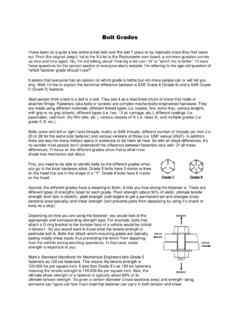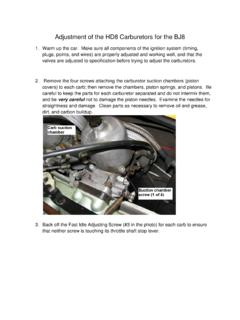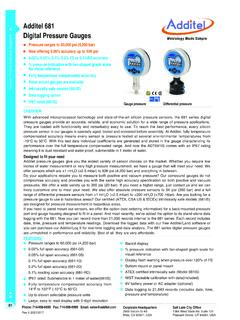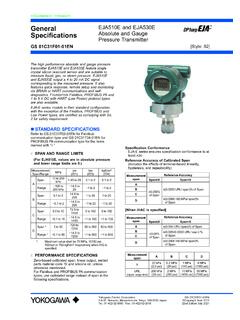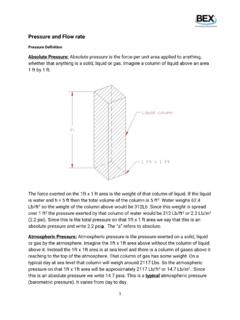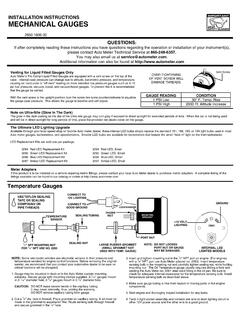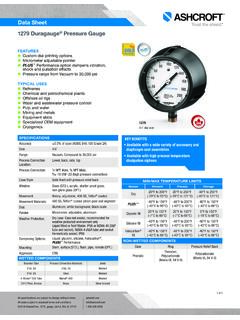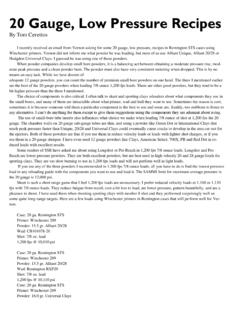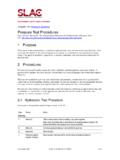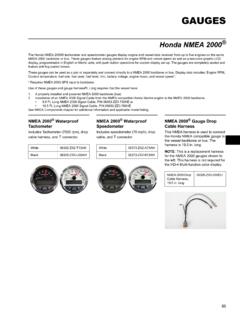Transcription of Nominal compression pressure
1 Cylinder compression pressure Table Bob Spidel and Harlan Polk Per Wikipedia: If the Nominal compression ratio of an engine is given, the pre-ignition cylinder pressure can be estimated using the following relationship: where is the cylinder pressure at bottom dead center (BDC) which is usually at 1 atm, is the compression ratio, and is the specific heat ratio for the working fluid, which is about for air, and for methane-air mixture. (But about for air-gasoline after accounting for engine heat.) For example, if an engine running on gasoline has a compression ratio is 10:1, the cylinder pressure at top dead center (TDC) is This figure, however, will also depend on cam ( valve) timing.
2 Generally, cylinder pressure for common automotive designs should at least equal 10 bar, or, roughly estimated in pounds per square inch (psi) as between 15 and 20 times the compression ratio, or in this case between 150 psi and 200 psi, depending on cam timing. Purpose-built racing engines, stationary engines etc. will return figures outside this range. Factors including late intake valve closure (relatively speaking for camshaft profiles outside of typical production car range, but not necessarily into the realm of competition engines) can produce a misleadingly low figure from this test. Excessive connecting rod clearance, combined with extremely high oil pump output (rare but not impossible) can sling enough oil to coat the cylinder walls with enough oil to facilitate reasonable piston ring seal artificially give a misleadingly high figure, on engines with compromised ring seal.
3 This can actually be used to some slight advantage. If a compression test does give a low figure, and it has been determined it is not due to intake valve closure/camshaft characteristics, then one can differentiate between the cause being valve/seat seal issues and ring seal by squirting engine oil into the spark plug orifice, in a quantity sufficient to disperse across the piston crown and the circumference of the top ring land, and thereby effect the mentioned seal. If a second compression test is performed shortly thereafter, and the new reading is much higher, it would be the ring seal that is problematic, whereas if the compression test pressure observed remains low, it is a valve sealing (or more rarely head gasket, or breakthrough piston or rarer still cylinder wall damage) issue.
4 If there is a significant (> 10%) difference between cylinders, that may be an indication that valves or cylinder head gaskets are leaking, piston rings are worn or that the block is cracked. If a problem is suspected then a more comprehensive test using a leak-down tester can locate the leak. compression Ratio Estimated Cylinder pressure @ TDC given 60% volumetric efficiency at cranking speed Percent Change from 8:1 CR Nominal Dynamic* PTDC = 1atmosphere volumetric efficiency Nominal [corrected air-gasoline specific heat factor]= for 10:1 CR & 60% VE, then psi = 176 psi psi = 161 psi gauge reading 7:1 :1 96 psi gauge reading -18% 8:1 :1 117 psi gauge reading 0% 9:1 :1 139 psi gauge reading 19% 10:1 :1 161 psi gauge reading 38% 11:1 :1 184 psi gauge reading 58% 12:1 :1 208 psi gauge reading 78% * at 60% volumetric efficiency at cranking speed, primarily due to valves open more than 180 degrees duration.
5

